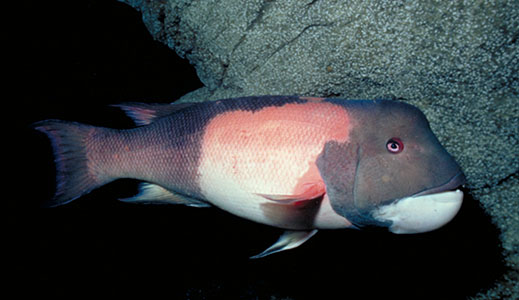San Francisco wears its uniqueness on its sleeve. We have countless festivals, parties and parades to celebrate being a city like no other, and in a place as open and welcoming as this, anyone can fit in. Likewise, there are some regional animals that reflect San Francisco’s unique spirit.

This California sheephead is in the male stage of its development. Photo courtesy of Aquarium of the Bay
By Mallory Johnson
Published: June, 2014
San Francisco wears its uniqueness on its sleeve. We have countless festivals, parties and parades to celebrate being a city like no other, and in a place as open and welcoming as this, anyone can fit in. Likewise, there are some regional animals that reflect San Francisco’s unique spirit. One fish that likely feels right at home is the California sheephead.
Part of the wrasse family, the California sheephead is a protogynous hermaphrodite. Simply put, all sheepheads are born as females, but eventually transform into males. That’s right, thanks to hormonal changes triggered by environmental and social cues, this fish can go from a reproductively-functional female to a fully-functional male.
Even a casual onlooker can tell what stage a sheephead is in by just looking at it. Sheepheads have three distinct appearances that are all closely correlated to their current sexual state. As juveniles, they sport an overall gold or salmon color with black spots on their fins and a silver stripe that runs the length of their bodies.
As they grow older into mature females, they ditch the spots and the stripe and turn into an all-over pink shade. After their final transformation from female to male, their appearance will change once again, this time with their heads and tails taking on a sleek black color while their midsections retain a stylish pink shade. A male sheephead also boasts a few other characteristics that its formal female self previously lacked—mainly a brand-new hump that appears on its head.
One thing that stays consistent in sheepheads throughout their transformation is their jaws, which remain white regardless of their current sex. The transitional phase from female to male can take anywhere between two weeks to several months to complete.
Almost all females will reach sexual maturity by the age of four, but the rate at which they transition into males can depend on a variety of factors, including location, size and other social factors. Generally, sheepheads will make their transition between five and eight years, but for some slower growing fish, they may never change sex at all. It’s also possible that aggressive interactions with overly-dominant males can suppress sex change in some females, and they won’t change unless the alpha male is removed from the environment.
Sexual transformation for the California sheephead takes place in the winter months between spawning seasons. Sheepheads tend to breed for a few months from July to October, and an individual sheephead may spawn up to 80 times annually. It is estimated that females will spawn anywhere between 36,000 and 296,000 eggs.
California sheepheads are polygamous, with the dominant males maintaining a harem of females. Males can get quite aggressive during the breeding season, defending their harems from other males that try to encroach on their territory.
California sheepheads typically live on rocky bottoms, particularly in kelp beds that offer a nice amount of protection from predators. They don’t tend to move around a lot, instead preferring to stick around the same reef. They are diurnal, meaning they hunt at day and seek shelter at night in crevices and caves. For an added level of protection from predators, they wrap themselves in a mucus cocoon that keeps predators from detecting their scent at night.
California sheepheads are conveniently equipped with protruding canine teeth. The teeth come in handy because sheepheads particularly like to dine on hard-shelled prey including sea urchins, mollusks, lobsters and crabs. After their powerful jaws and sharp teeth crush their prey, they use modified throat bones known as a throat plate to grind the shells into small pieces.
You can learn more about the California sheephead and see them in the Under the Bay exhibit at Aquarium of the Bay. From June 27-29, Aquarium of the Bay will be celebrating pride weekend with special presentations focused on the California sheephead and other fabulous fish of the Bay.


